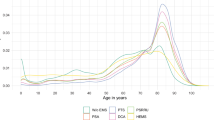Abstract
Objectives
Emergency department (ED) crowding leads to poor outcomes. Patients with respiratory conditions like chronic obstructive pulmonary disease (COPD) are especially vulnerable to crowding-related delays in care. We aimed to assess the associations of ED crowding metrics with outcomes for patients presenting with COPD.
Methods
We conducted a population-based cohort study of adult patients presenting with a diagnosis of COPD to 18 high-volume EDs between 2014 and 2019 in Alberta, Canada. Administrative databases provided date and time data on key stages of the presentation including physician initial assessment and disposition decision. Crowding metrics were calculated using facility-specific median physician initial assessment and length of stay. Patient presentations were grouped by acuity and mixed-effects regression models were fit to adjust for the clustering at the facility level.
Results
There were 49,085 presentations for COPD made by 25,734 patients (median age = 73 years). A 1-h increase in the physician initial assessment metric was associated with an increase in physician initial assessment for COPD patients by 23, 53, and 59 min for the high, moderate, and low acuity groups, respectively, adjusted for other predictors. For the low acuity group, this metric was associated with an increased length of stay of 73 min for admitted individuals. Similarly, an increase in the length of stay metric was also associated with an increased likelihood of being admitted for all acuity groups.
Conclusions
For patients with COPD, ED crowding results in delays in assessment increased length of stay, and increased proportion of patients admitted. These results suggest that ED crowding mitigation efforts to provide timely care for patients with COPD are urgently needed.
Trial registration
N/A.
Résumé
Objectifs
L'encombrement des services d'urgence entraîne de mauvais résultats. Les patients souffrant de maladies respiratoires telles que la maladie pulmonaire obstructive chronique (MPOC) sont particulièrement vulnérables aux retards de soins liés à l'encombrement. Notre avons cherché à évaluer les associations entre les paramètres d'encombrement des services d'urgence et les résultats pour les patients présentant une MPOC.
Méthodes
Nous avons mené une étude de cohorte basée sur la population de patients adultes se présentant avec un diagnostic de MPOC dans dix-huit services d'urgence à haut volume entre 2014 et 2019 en Alberta, au Canada. Les bases de données administratives ont fourni des données sur la date et l'heure des principales étapes de la présentation, y compris l'évaluation initiale par le médecin et la décision de sortie. Les mesures d'encombrement ont été calculées à partir de l'évaluation initiale médiane du médecin et de la durée du séjour propres à l'établissement. Les présentations des patients ont été regroupées par gravité et des modèles de régression à effets mixtes ont été ajustés pour tenir compte du regroupement au niveau de l'établissement.
Résultats
Il y a eu 49 085 présentations pour la MPOC effectuées par 25 734 patients (âge médian = 73 ans). Une augmentation d'une heure de l'évaluation initiale par le médecin était associée à une augmentation de l'évaluation initiale par le médecin pour les patients atteints de MPOC de 23, 53 et 59 min pour les groupes de gravité élevée, modérée et faible, respectivement, après ajustement pour d'autres facteurs prédictifs. Pour le groupe de faible gravité, ce paramètre était associé à une augmentation de la durée de séjour de 73 min pour les personnes admises. De même, une augmentation de la durée du séjour était également associée à une probabilité accrue d'admission pour tous les groupes de gravité.
Conclusions
Pour les patients atteints de MPOC, l'encombrement des urgences entraîne des retards dans l'évaluation, une augmentation de la durée du séjour et une augmentation de la proportion de patients admis. Ces résultats suggèrent qu'il est urgent d'atténuer l'encombrement des urgences afin de fournir des soins en temps opportun aux patients atteints de MPOC.
Enregistrement de l'essai
N/A.

Similar content being viewed by others
Data availability
Data is the property of Alberta Health and the authors are not allowed to provide the data. Requests can be made for the same data from Alberta Health for researchers who meet the criteria for access to confidential data. Researchers are welcome to inquire for further information at Health.RESDATA@gov.ab.ca.
References
Moskop JC, Sklar DP, Geiderman JM, Schears RM, Bookman KJ. Emergency department crowding, part 1-concept, causes, and moral consequences. Ann Emerg Med. 2009;53(5):605–11.
Pines JM, Hollander JE, Localio AR, Metlay JP. The association between emergency department crowding and hospital performance on antibiotic timing for pneumonia and percutaneous intervention for myocardial infarction. Acad Emerg Med. 2006;13(8):873–8.
Schull MJ, Vermeulen M, Slaughter G, Morrison L, Daly P. Emergency department crowding and thrombolysis delays in acute myocardial infarction. Ann Emerg Med. 2004;44(6):577–85.
Johnson KD, Winkelman C. The effect of emergency department crowding on patient outcomes: a literature review. Adv Emerg Nurs J. 2011;33(1):39–54.
Pines JM, Hilton JA, Weber EJ, Alkemade AJ, Al Shabanah H, Anderson PD, et al. International perspectives on emergency department crowding. Acad Emerg Med. 2011;18(12):1358–70.
Bernstein SL, Aronsky D, Duseja R, Epstein S, Handel D, Hwang U, et al. The effect of emergency department crowding on clinically oriented outcomes. Acad Emerg Med. 2009;16(1):1–10.
Fee C, Weber EJ, Maak CA, Bacchetti P. Effect of emergency department crowding on time to antibiotics in patients admitted with community-acquired pneumonia. Ann Emerg Med. 2007;50(5):501–9.e1.
Jang H, Ozkaynak M, Ayer T, Sills MR. Factors associated with first medication time for children treated in the emergency department for asthma. Pediatr Emerg Care. 2021;37(1):e42–7.
Sills MR, Fairclough D, Ranade D, Kahn MG. Emergency department crowding is associated with decreased quality of care for children with acute asthma. Ann Emerg Med. 2011;57(3):191–200.e7.
Crighton EJ, Ragetlie R, Luo J, To T, Gershon A. A spatial analysis of COPD prevalence, incidence, mortality and health service use in Ontario. Health Rep - Stat Canada. 2015;26(3):10–8.
Charbonneau V, Kwok E, Boyle L, Stiell IG. Impact of emergency department surge and end of shift on patient workup and treatment prior to referral to internal medicine: a health records review. Emerg Med J. 2018;35(5):309–15.
Feinleib M, Rosenberg HM, Collins JG, Delozier JE, Pokras R, Chevarley FM. Trends in COPD morbidity and mortality in the United States. Am Rev Respir Dis. 1989;140(3 Pt 2):S9–18.
Wedzicha JA, Donaldson GC. Exacerbations of chronic obstructive pulmonary disease. Respir Care. 2003;48(12):1204–13.
Hwang U, McCarthy ML, Aronsky D, Asplin B, Crane PW, Craven CK, et al. Measures of crowding in the emergency department: a systematic review. Acad Emerg Med. 2011;18(5):527–38.
Canadian Institute for Health Information. ICD-10-CA (International Statistical Classification of Diseases and Related Health Problems), 10th Revision. Ottawa, ON: Canadian Institute for Health Information; 2020.
Gravel J, Manzano S, Arsenault M. Validity of the Canadian paediatric triage and acuity scale in a tertiary care hospital. Can J Emerg Med. 2009;11(1):23–8.
Bullard MJ, Unger B, Spence J, Grafstein E. Revisions to the Canadian Emergency Department Triage and Acuity Scale (CTAS) adult guidelines. Can J Emerg Med. 2008;10(2):136–51.
Wilkins R, Peters PA. PCCF + Version 5K* User's Guide. Automated geographic coding based on the Statistics Canada Postal Code Conversion Files, Including Postal Codes through May 2011. Ottawa, ON: Statistics Canada; 2012.
Charlson ME, Pompei P, Ales KL, MacKenzie CR. A new method of classifying prognostic comorbidity in longitudinal studies: development and validation. J Chronic Dis. 1987;40(5):373–83.
Medicore (Firm). ICD-9-CM: International classification of diseases, 9th revision, clinical modification. Salt Lake City, Utah: Medicore; 1996.
Canadian Institute for Health Information. eNACRS Reports: Emergency Department Wait Time Indicators. Ottawa, Ontario: Canadian Institute for Health Information; 2012.
SAS Institute Inc. SAS/ACCESS® 9.4 Interface to ADABAS: Reference. Cary, NC: SAS Institute Inc.; 2013.
R Core Team. R: A language and environment for statistical computing. 4.0.4 ed. Vienna, Austria: R Foundation for Statistical Computing; 2021.
Sagaidak S, Rowe BH, Ospina MB, Rosychuk RJ. Emergency department crowding negatively influences outcomes for children presenting with asthma: a population-based retrospective cohort study. Pediatr Res. 2021;89(3):679–85.
Rasouli HR, Esfahani AA, Nobakht M, Eskandari M, Mahmoodi S, Goodarzi H, et al. Outcomes of crowding in emergency departments; a systematic review. Arch Acad Emerg Med. 2019;7(1): e52.
Ouyang H, Wang J, Sun Z, Lang E. The impact of emergency department crowding on admission decisions and patient outcomes. Am J Emerg Med. 2022;51:163–8.
O’Donnell DE, Aaron S, Bourbeau J, Hernandez P, Marciniuk DD, Balter M, et al. Canadian thoracic society recommendations for management of chronic obstructive pulmonary disease - 2007 update. Can Respir J. 2007;14:5b–32b.
Affleck A, Parks P, Drummond A, Rowe BH, Ovens HJ. Emergency department overcrowding and access block. Can J Emerg Med. 2013;15(6):359–84.
Holroyd BR, Bullard MJ, Latoszek K, Gordon D, Allen S, Tam S, et al. Impact of a triage liaison physician on emergency department overcrowding and throughput: a randomized controlled trial. Acad Emerg Med. 2007;14(8):702–8.
Rowe BH, Guo X, Villa-Roel C, Schull M, Holroyd B, Bullard M, et al. The role of triage liaison physicians on mitigating overcrowding in emergency departments: a systematic review. Acad Emerg Med. 2011;18(2):111–20.
Bullard MJ, Villa-Roel C, Guo X, Holroyd BR, Innes G, Schull MJ, et al. The role of a rapid assessment zone/pod on reducing overcrowding in emergency departments: a systematic review. Emerg Med J. 2012;29(5):372–8.
Oredsson S, Jonsson H, Rognes J, Lind L, Göransson KE, Ehrenberg A, et al. A systematic review of triage-related interventions to improve patient flow in emergency departments. Scand J Trauma Resusc Emerg Med. 2011;19:43.
Jones S, Moulton C, Swift S, Molyneux P, Black S, Mason N, et al. Association between delays to patient admission from the emergency department and all-cause 30-day mortality. Emerg Med J. 2022;39(3):168.
Wessman T, Ärnlöv J, Carlsson AC, Ekelund U, Wändell P, Melander O, et al. The association between length of stay in the emergency department and short-term mortality. Intern Emerg Med. 2022;17(1):233–40.
De Freitas L, Goodacre S, O’Hara R, Thokala P, Hariharan S. Interventions to improve patient flow in emergency departments: an umbrella review. Emerg Med J. 2018;35(10):626–37.
Acknowledgements
The authors would like to thank Meng Lin of the Alberta SPOR data platform and AHS Research Data Services for providing health datasets. The authors would also like to thank Larry Laliberte at the University of Alberta for providing the Statistics Canada data.
Funding
Dr. Rowe’s research is supported by a Scientific Director’s Grant (SOP 168483) from the Canadian institutes of Health Research (CIHR) through the Government of Canada (Ottawa, ON). These funding organizations were not involved in any aspect of the conduct, analysis, or manuscript preparation of this research; CIHR takes no responsibility for the results reported in this manuscript.
Author information
Authors and Affiliations
Contributions
SSO performed the statistical analysis and assisted with modeling analysis, interpreted results, and drafted and reviewed the manuscript. YH assisted with statistical and performed the modeling analyses, and reviewed the manuscript. BHR conceptualized and designed the study, interpreted results, and reviewed and revised the manuscript. BZ interpreted results, and reviewed and revised the manuscript. RJR conceptualized and designed the study, coordinated data extraction, and provided project oversight by directing statistical analyses, interpreting results, and reviewing and revising the manuscript. RJR is the guarantor for this manuscript and accepts responsibility for all aspects.
Corresponding author
Ethics declarations
Conflict of interest
The authors have no conflicts of interest to disclose.
Supplementary Information
Below is the link to the electronic supplementary material.
Rights and permissions
Springer Nature or its licensor (e.g. a society or other partner) holds exclusive rights to this article under a publishing agreement with the author(s) or other rightsholder(s); author self-archiving of the accepted manuscript version of this article is solely governed by the terms of such publishing agreement and applicable law.
About this article
Cite this article
Ortiz, S.S., Huang, Y., Rowe, B.H. et al. Emergency department crowding negatively influences outcomes for adults presenting for chronic obstructive pulmonary disease. Can J Emerg Med 25, 411–420 (2023). https://doi.org/10.1007/s43678-023-00502-5
Received:
Accepted:
Published:
Issue Date:
DOI: https://doi.org/10.1007/s43678-023-00502-5




